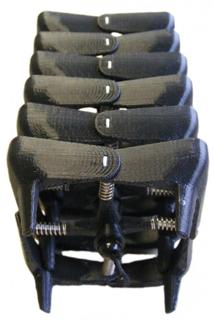Jul 3 2015
Inspiration for the next big technological breakthrough in robotics, defense systems and biomedicine could come from a seahorse's tail, according to a new study reported Thursday in the journal Science.
 The researchers designed this 3-D-printed model based on the design of a seahorse tail. Credit:Clemson University
The researchers designed this 3-D-printed model based on the design of a seahorse tail. Credit:Clemson University
The research centers on the curious shape of seahorse tails and was led by Clemson University's Michael M. Porter, an assistant professor of mechanical engineering.
Seahorse tails are organized into square prisms surrounded by bony plates that are connected by joints. Many other creatures, ranging from New World monkeys to rodents, have cylindrical tails.
Researchers wanted to know whether the square-prism shape gives seahorse tails a functional advantage.
To find out, the team created a 3D-printed model that mimicked the square prism of a seahorse tail and a hypothetical version that was cylindrical. Then researchers whacked the models with a rubber mallet and twisted and bent them.
Researchers found that the square prototype was stiffer, stronger and more resilient than the circular one when crushed. The square prototype was about half as able to twist, a restriction that could prevent damage to the seahorse and give it better control when it grabs things.
Both prototypes could bend about 90 degrees, although the cylindrical version was slightly less restricted.
Porter said the seahorse tail could inspire new forms of armor. It could also lead to search-and-rescue robots that move on the ground like a snake and are able to contract to fit into tight spaces.
"We haven't gotten that far with the applications side of things yet, but we see a lot of potential with this device because it's so unique," Porter said.
The study's co-authors are Dominique Adriaens of Ghent University in Belgium; Ross L. Hatton of Oregon State University; and Marc A. Meyers and Joanna McKittrick, both of the University of California, San Diego.
Porter said that he built the models and gathered data while he was Ph.D. student at UC San Diego. He graduated in June 2014 and began work at Clemson the following August. He did all the analysis and writing for the study at Clemson.
For Porter, the next step is to build a robot using what he's learned about seahorse tails. He is in the early stages of research with two Clemson professors: Ian Walker, a professor in the Holcombe Department of Electrical Engineering and Computer Science, and Richard Blob, a biological sciences professor.
"Part of the reason I came to Clemson was this research," Porter said.
Anand Gramopadhye, dean of the College of Engineering and Science, said the study shows that Clemson is attracting some of the nation's top talent.
"Science is a premiere academic journal that is highly selective about what it publishes," he said. "The article shows the exemplary level of scholarship that Dr. Porter brings to Clemson University. I congratulate him and his team."
Science is the world's largest peer-reviewed general science journal.
For years, engineers have been taking inspiration from nature to design new technologies. The Porter-led study did that, but took things a step further. Researchers used engineering to learn more about nature.
New technologies, such as 3D printing, allow researchers "to build idealized models of natural systems to better understand their different functions," Porter said.
"This study demonstrates that engineering designs are convenient means to answer elusive biological questions when biological data are nonexistent or difficult to obtain," researchers wrote in the article. "In addition, understanding the role of mechanics in these biologically inspired designs may help engineers to develop seahorse-inspired technologies for a variety of applications in robotics, defense systems, or biomedicine."
Congratulations also came Melur K. Ramasubramanian, chair of the mechanical engineering department.
"Dr. Porter has begun to have a big impact even though he has been at Clemson for a short time," Ramasubramanian said. "We're thrilled to have him in the department of mechanical engineering."